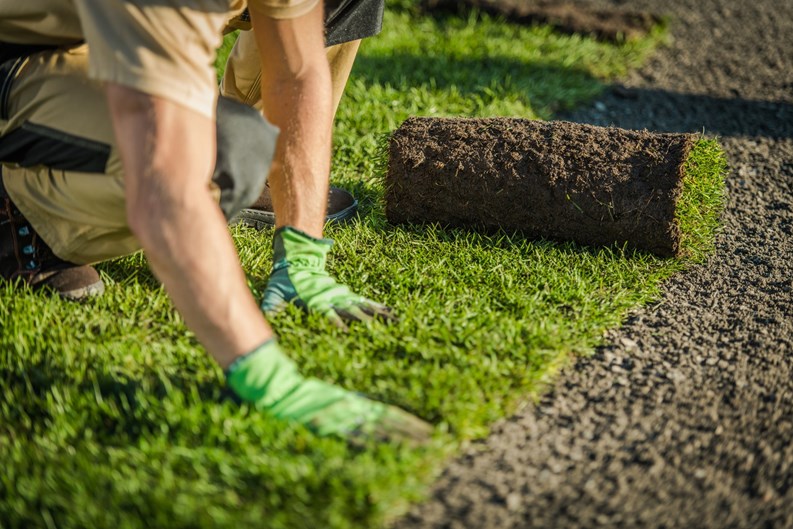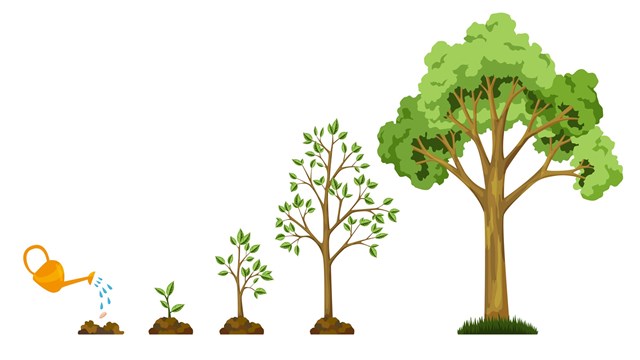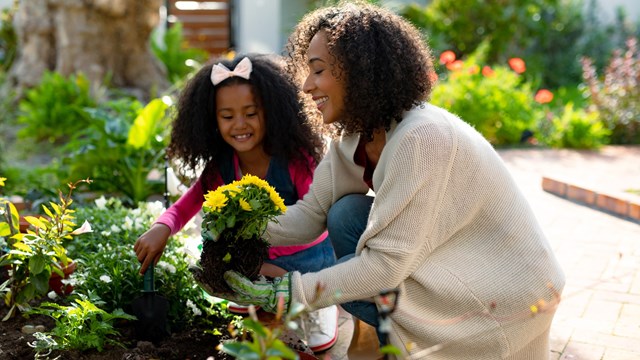In multifamily properties, different households share in the use, visual enjoyment, and enhanced property value of landscaped outdoor elements. That means that a lot of consideration goes into deciding what and where to plant, how to maintain it, and how much to spend on it all. These considerations can be summed up as the ‘Three Greens’: the vitality and vibrancy of lawns and other plantings—their literal greenness—the dollars that condos and co-ops invest to design, install, and maintain these areas; and the ecological factors that determine the best practices, placements, and products that use the least resources and have the best environmental impacts.
The three greens of landscaping must be considered simultaneously to maximize each. For example, an association with a limited landscaping budget might think that skimping on mulch will save them money—but the right type of mulch in the right amounts is important for soil health, water conservation, and weed mitigation, according to the pros. Similarly, a community with ample grounds might think that laying a bunch of sod for sprawling lawns might be the right way to ‘green’—but this type of landscape might actually be the least cost effective to maintain and least ecologically efficient and/or beneficial.
Mix It Up
Generally, as with most things biological, diversity is best. Having a combination of softscape (plantings and grasses) and hardscape (concrete, paving, turf) creates visual appeal and can differentiate outdoor spaces for a variety of uses. A carefully planned landscape can also maximize water run-off and absorption, take advantage of sun and shade, make use of otherwise dead space, and account for seasonality—a particularly important consideration in the face of climate change and the severe weather events it can bring to all regions.
Similarly, mixing in plants native to the region where they’re being planted has both maintenance and sustainability benefits. According to Steven Yergeau, Agriculture and Natural Resources Agent for Ocean and Atlantic Counties and member of the New Jersey Landscape Contractors Association (NJLCA), “Native plants are a good way to incorporate sustainable vegetation into yards for clients who are environmentally minded. Native plants are adapted to local climate and soil conditions, requiring less watering, fertilizers, and pesticides than non-native vegetation.” The National Wildlife Federation has launched a Native Plant Finder on its website: www.nwf.org/nativeplantfinder/. Enter your zip code, and find all the flowers, grasses, trees, and shrubs that are native to your area.
Tom Lupfer, owner of Lupfer Landscaping in Lyons, Illinois, and member of the Illinois Landscape Contractors Association (ILCA), contends that an integrated landscape approach will also become a more sustainable system. Where plants are dying or struggling, he says, pests tend to proliferate, which increases the need for chemical applications. This has further negative consequences for the health and vitality of the landscape. “When you put down herbicides, for example,” says Lupfer, “you kill not only the harmful elements, but many of the beneficial microbes that foster life and growth in the soil. The soil becomes barren, in a way, and has to be supplemented artificially, which means more chemicals.” As with any organic system, the less need for intervention, the better. Native plants are more likely to thrive on their own in the conditions natural to the region, requiring fewer chemicals, less watering, and less impact.
Go for Low Maintenance
A sustainable landscape is one that minimizes use of non-renewable resources, according to the Environmental Protection Agency (EPA). The less we can apply chemicals, fertilizers, pesticides, and even water to our manicured environments, the better it is for both our planet and our pocketbook. These resources are not only expensive, but their overuse can have negative effects on the environment and our health.
The move to a sustainable landscape need not be immediate, nor need it be an extreme overhaul of an existing plan. “The whole goal of moving toward sustainability is to subtly change it into a more vibrant-looking landscape and create a healthier environment,” Lupfer says. “It should be a process of transitioning from a traditional landscape to a more sustainable one. A healthier landscape means that plants don’t need as much attention, since they are growing as they should and are not afflicted by disease and don’t need artificial food to keep them alive and flourishing.”
One quick and easy way to save green by going green is to control irrigation. Lupfer estimates that watering plants and grasses only as needed, rather than using a timer or other automatic schedule, can save 60% to 70% percent on water bills. These savings can really add up over time, and require little to no initial financial output. “You don’t have to put in new systems or spend any money up front,” he advises of this practice. “This is something everyone can do right now.”
Look Toward the Future
Even a small investment into a property’s landscape design or maintenance can have big payoffs for the long-term financial and physical success of the association or corporation. Concomitantly, what might seem like a costly change or addition now might have positive repercussions for the future. Investing in permeable pavers, for example, requires less land for drainage solutions like retention ponds or drains, notes Lupfer, leaving that land available for other uses. A thoughtful plan for an underused outdoor space can add value and desirability for a community and its homeowners. The benefits are exponential.
Making landscaping decisions that keep in mind the changes to the environment brought about by climate change and other factors is also a smart move. David Mendelson and Anna Maria Morales of QG Landscape based in New York tell CooperatorNews that in new developments, builders and designers are planning outdoor space that can remain open further through the seasons. They are accounting for not only climate change, but the changes currently taking place as a result of the coronavirus pandemic. “Outdoor spaces have always been a sought-after commodity,” says Morales. “Now with COVID, everyone wants to social distance, and they want to be outside. … We have to adapt to the new normal.”
Martin Rosen of the Office of Planning and Sustainable Communities at the New Jersey Department of Environmental Protection reinforces the benefits of a holistic approach to landscape design and maintenance. He says, “As land itself becomes scarce and ever more precious, outdoor spaces need to be designed to deliver value in as many ways as possible; i.e., increasing land values, rewarding the senses, promoting environmental quality, and enhancing mobility. Sustainable landscapes incorporate and balance the human desire for beautiful and functional landscapes with the imperative to preserve valuable resources.” Looking at every aspect of a development site—its topography and layout, natural and artificial lighting, hardscape and softscape, vegetation, irrigation, and intended or potential uses—can create a landscape that is sustainable both now and for years to come.
It’s Easy Being Green
Contrary to Kermit the Frog’s famous assertion, being green can be easy—and this goes for multifamily properties, too. Even small and inexpensive changes to the way an association or corporation plans and maintains its outdoor spaces can have major implications for the value of the property, the health of the earth and its inhabitants, and the community’s bottom line. Understanding the interrelationship among the three greens—plantings, money, and sustainability—will help any condo, HOA, or co-op achieve a beautiful landscape that is pleasing and useful to residents, friendly and beneficial to the planet, and a long-term value proposition for today’s challenging times.
Darcey Gerstein is Associate Editor and Staff Writer for CooperatorNews.







Leave a Comment